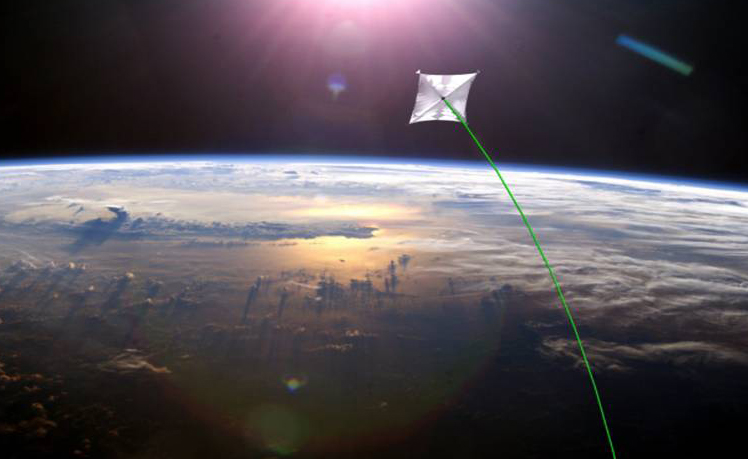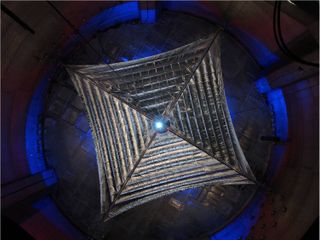
A huge solar sail designed to demonstrate the viability and value of propellant-free propulsion is slated to blast into space in November 2014, mission officials say.
NASA's Sunjammer spacecraft — whose 13,000-square-foot (1,208 square meters) sail will allow it to cruise through the heavens like a boat through the ocean — is scheduled to lift off atop a SpaceX Falcon 9 rocket from Florida's Cape Canaveral late next year.
Sunjammer will be a secondary payload on the Falcon 9, whose main task is launching the National Oceanic and Atmospheric Administration's Deep Space Climate Observatory (DSCOVR) toward a gravitationally stable location called the Sun-Earth Lagrange Point 1, which lies about 900,000 miles (1.5 million kilometers) from our planet. [Photos: Solar Sail Evolution for Space Travel]

Sunjammer will likely separate from the Falcon 9 shortly after DSCOVR does. The spacecraft will then deploy its enormous sail, which measures 124 feet (38 m) on a side, and head toward a desired location about 1.8 million miles (3 million km) from Earth, pushed along by photons streaming from the sun.
While Sunjammer will monitor space weather using several different instruments, the $27 million mission's primary goal is to help prove out and advance solar sail technology, which proponents say could power future missions cheaply and efficiently.
"We're excited about seeing Sunjammer unfurl and successfully sail next year, providing the propellant for its own mission, as well as whole new space mission concepts of the future," Michael Gazarik, NASA associate administrator for space technology, said in a statement.
Once proven out, solar sails could be affixed to a fleet of sun-studying spacecraft to provide a beefed-up space weather warning system, researchers say. Sails could also aid in the cost-effective removal of decommissioned satellites and other space junk, or allow craft to hover above Earth's high latitudes for communications and observation purposes.
Get the Space.com Newsletter
Breaking space news, the latest updates on rocket launches, skywatching events and more!
Engineers are also considering solar sails for deep-space propulsion. For example, a sail-equipped craft could conceivably travel to another star system in just a few centuries — as long as the sail is the size of Texas and a space-based laser shines a super-powerful beam on it as the vehicle recedes into the depths of space.
NASA chose California-based L'Garde, Inc. to build Sunjammer, which takes its name from a solar-sailing spaceship in an Arthur C. Clarke short story. Though the unfurled sail covers one-third of an acre (0.13 hectares), it packs down to the size of a dishwasher. It's made of a material called Kapton and weighs just 70 pounds (32 kilograms), NASA officials say.
While Sunjammer will be the biggest solar sail ever deployed in space, it won't be the first. Japan's Ikaros probe unfurled a 46-foot-wide (14 m) sail in June 2010, becoming the first craft ever to cruise through space propelled only by sunlight.
Five months later, NASA launched its NanoSail-D demonstrator craft, which sported a solar sail with a surface area of about 110 square feet (10 square m). NanoSail-D deployed its sail in January 2011, then zipped around the Earth for 240 days before burning up in the planet's atmosphere.
Follow Mike Wall on Twitter @michaeldwall and Google+. Follow us @Spacedotcom, Facebook or Google+. Originally published on SPACE.com.
Join our Space Forums to keep talking space on the latest missions, night sky and more! And if you have a news tip, correction or comment, let us know at: community@space.com.

Michael Wall is a Senior Space Writer with Space.com and joined the team in 2010. He primarily covers exoplanets, spaceflight and military space, but has been known to dabble in the space art beat. His book about the search for alien life, "Out There," was published on Nov. 13, 2018. Before becoming a science writer, Michael worked as a herpetologist and wildlife biologist. He has a Ph.D. in evolutionary biology from the University of Sydney, Australia, a bachelor's degree from the University of Arizona, and a graduate certificate in science writing from the University of California, Santa Cruz. To find out what his latest project is, you can follow Michael on Twitter.